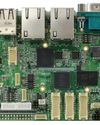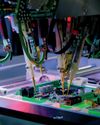Bringing Cost-Effective, On-Device AI to Home Appliances - Sparse Weights and Interactions Negate GPUs and Cloud Computing
Circuit Cellar
|September 2024
GPU silicon and cloud computing infrastructure are too costly for mass markets devices like refrigerators and washers. By deploying compute resources only to the necessary parts of AI inference, Sparse AI allows product designers to practically incorporate new AI features like natural voice interfaces into their consumer offerings without breaking the bank or electric bill surprises.

Artificial Intelligence (AI) is changing every aspect of consumer product design. Manufacturers are discovering new ways to deploy AI into their products to differentiate in the market with new capabilities, improved efficiency, and reduced operating costs. However, the extreme processing requirements of AI have led manufacturers to implement AI either on-device using a high-cost, AI-capable chip, with a connection to cloud-based AI infrastructure, or both.
These approaches incur design and operating costs that have priced AI out of all but the highest-end products in markets such as white goods/home appliances and other consumer electronics applications. To make AI accessible to cost-sensitive mass markets, we need to bring costs down. This is where sparse AI technology can help. By optimizing AI inference processing by up to 100 times, sparse AI enables developers to implement complex, deep-learning-based AI models using low-cost AI MCU silicon without adversely impacting speed, efficiency, memory footprint, or performance. This article will explore sparse AI and how manufacturers can optimize AI inferencing to reduce cloudbased dependency and infrastructure or even implement powerful AI-based capabilities completely on-device.
SPARSE AI
AI models can be complex and require extensive processing resources and memory. In high-end AI systems, a specialized (and expensive) processor like a GPU runs AI model inferencing on-device. Alternatively, many systems take a cloud-based approach where data is collected on-device and sent to a server for processing.
Dit verhaal komt uit de September 2024-editie van Circuit Cellar.
Abonneer u op Magzter GOLD voor toegang tot duizenden zorgvuldig samengestelde premiumverhalen en meer dan 9000 tijdschriften en kranten.
Bent u al abonnee? Aanmelden
MEER VERHALEN VAN Circuit Cellar

Circuit Cellar
The Future of Sensors in Safety Systems Sensing the Stop
How Magnetic Sensors Are Enabling the Next Generation of Braking Systems
5 mins
December 2025
Circuit Cellar
Alif Semiconductor Elevates Generative AI at the Edge with New Support for ExecuTorch Runtime in Its Ensemble MCUs
Alif Semiconductor, the leading global supplier of secure, connected, power efficient Artificial Intelligence and Machine Learning (AI/ML) microcontrollers (MCUs) and fusion processors, announced that developers can now use the ExecuTorch Runtime, a quantization extension of the popular PyTorch ML framework, for AI applications built to run on its Ensemble E4/E6/E8 series of MCUs and fusion processors.
1 min
December 2025

Circuit Cellar
Encrypted MQTT Protocol for Critical Sectors
Mechanisms, Challenges, and Best Practices
3 mins
December 2025

Circuit Cellar
Datasheet: Small Size, Big Power
Smaller Microcontrollers Bring New Possibilities
9 mins
December 2025

Circuit Cellar
Analog Devices Launches ADI Power Studio and New Web-Based Tools
Analog Devices, Inc. (ADI), a global semiconductor leader, announced the launch of ADI Power Studio, a comprehensive family of products that offers advanced modeling, component recommendations, and efficiency analysis with simulation.
1 mins
December 2025

Circuit Cellar
Compact IBR300 2.5" SBC Powered by NXP i.MX 93 from IBASE
IBASE Technology, Inc., a leading provider of rugged embedded computing platforms, announced the release of the IBR300, a 2.5\" RISC-based single board computer (SBC) powered by the NXP i.MX 93 processor with dualcore ARM Cortex-A55 (up to 1.7GHz) and a Cortex-M33 MCU.
1 min
December 2025

Circuit Cellar
Sensors in the Spotlight
The Next Decade of Embedded Sensor Systems
12 mins
December 2025

Circuit Cellar
Bob's Wrap Up
In Bob's last article with Circuit Cellar, he attempts to wrap up a career of more than 50 years as an embedded systems engineer and 14 years with Circuit Cellar. He looks at each of his 58 articles by category and provides some recommendations for his fellow engineers.
7 mins
December 2025

Circuit Cellar
Designing Embedded Software Architectures That Last
I've reviewed hundreds of firmware projects over the years, and one thing always stands out: the most successful projects have a clear, deliberate architecture.
10 mins
December 2025
Circuit Cellar
Broadcom Introduces Industry's First Wi-Fi 8 Silicon Ecosystem Powering the AI Era
Broadcom, Inc. unveiled the first Wi-Fi 8 silicon solutions for broadband wireless, targeting residential gateways, enterprise access points, and smart mobile clients.
1 mins
December 2025
Listen
Translate
Change font size

